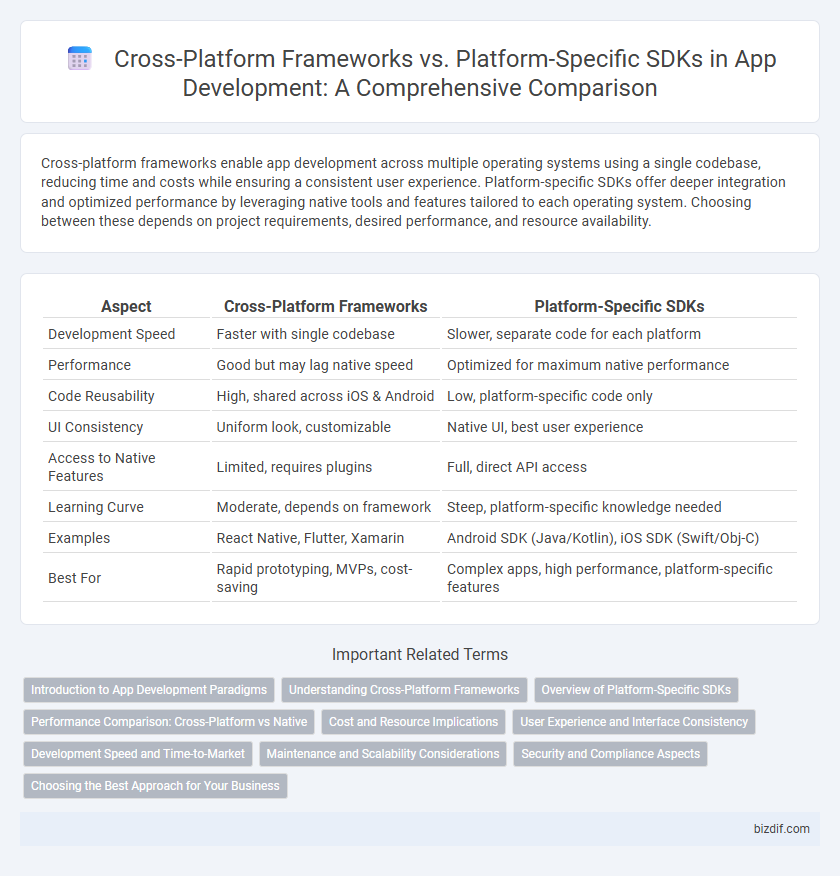Cross-platform frameworks enable app development across multiple operating systems using a single codebase, reducing time and costs while ensuring a consistent user experience. Platform-specific SDKs offer deeper integration and optimized performance by leveraging native tools and features tailored to each operating system. Choosing between these depends on project requirements, desired performance, and resource availability.
Table of Comparison
| Aspect | Cross-Platform Frameworks | Platform-Specific SDKs |
|---|---|---|
| Development Speed | Faster with single codebase | Slower, separate code for each platform |
| Performance | Good but may lag native speed | Optimized for maximum native performance |
| Code Reusability | High, shared across iOS & Android | Low, platform-specific code only |
| UI Consistency | Uniform look, customizable | Native UI, best user experience |
| Access to Native Features | Limited, requires plugins | Full, direct API access |
| Learning Curve | Moderate, depends on framework | Steep, platform-specific knowledge needed |
| Examples | React Native, Flutter, Xamarin | Android SDK (Java/Kotlin), iOS SDK (Swift/Obj-C) |
| Best For | Rapid prototyping, MVPs, cost-saving | Complex apps, high performance, platform-specific features |
Introduction to App Development Paradigms
Cross-platform frameworks enable developers to write a single codebase compatible with multiple operating systems, reducing development time and costs. Platform-specific SDKs offer optimized performance and deeper access to native features, ensuring enhanced user experience and system integration. Choosing between these paradigms depends on project requirements, target audience, and resource availability.
Understanding Cross-Platform Frameworks
Cross-platform frameworks enable developers to write a single codebase that runs seamlessly on multiple operating systems, significantly reducing development time and costs. Popular frameworks like React Native, Flutter, and Xamarin provide access to native device features through standardized APIs while maintaining near-native performance. These tools streamline app updates and maintenance by allowing simultaneous deployment across iOS, Android, and web platforms.
Overview of Platform-Specific SDKs
Platform-Specific SDKs provide developers with native tools, libraries, and APIs designed explicitly for a single operating system, such as iOS's Xcode with Swift or Android Studio with Kotlin. These SDKs enable access to device-specific features, optimized performance, and seamless integration with native user interface components, resulting in highly responsive and reliable applications. Despite requiring separate codebases for each platform, Platform-Specific SDKs often deliver superior user experiences and full utilization of hardware capabilities compared to cross-platform frameworks.
Performance Comparison: Cross-Platform vs Native
Cross-platform frameworks often trade some level of performance for flexibility, as they rely on abstraction layers that can introduce latency compared to platform-specific SDKs optimized for native hardware and OS capabilities. Native development with platform-specific SDKs, such as Swift for iOS or Kotlin for Android, delivers superior responsiveness and efficient memory management by leveraging direct access to system resources. Performance-critical applications, especially those requiring intense graphics rendering or real-time processing, benefit significantly from native SDKs over cross-platform alternatives like React Native or Flutter.
Cost and Resource Implications
Cross-platform frameworks reduce development costs by enabling code reuse across multiple platforms, significantly minimizing resource allocation compared to platform-specific SDKs that require separate codebases for iOS and Android. While platform-specific SDKs offer optimized performance and access to native features, they demand higher investment in specialized developers and longer development cycles. Budget-conscious projects benefit from cross-platform frameworks like Flutter or React Native, which streamline maintenance and updates across diverse devices.
User Experience and Interface Consistency
Cross-platform frameworks like Flutter and React Native enable developers to build apps with consistent user interfaces across multiple devices, reducing development time while maintaining a unified experience. Platform-specific SDKs such as Swift for iOS and Kotlin for Android provide deeper access to native features and performance optimizations, resulting in smoother animations and more responsive interactions tailored to each operating system. Balancing interface consistency with native performance is crucial for delivering superior user experience in app development.
Development Speed and Time-to-Market
Cross-platform frameworks like React Native and Flutter significantly accelerate development speed by enabling code reuse across iOS and Android, reducing duplication and streamlining updates. Platform-specific SDKs, such as Swift for iOS or Kotlin for Android, offer optimized performance and access to native APIs but require separate codebases, increasing development time and delaying time-to-market. For rapid launches and cost-effective maintenance, cross-platform solutions provide a strategic advantage in shortening development cycles and improving market responsiveness.
Maintenance and Scalability Considerations
Cross-platform frameworks streamline maintenance by enabling a single codebase to run on multiple platforms, reducing update cycles and bug fixes compared to platform-specific SDKs that require separate maintenance. Scalability benefits from cross-platform solutions by allowing businesses to extend features and support various devices without rewriting code, whereas platform-specific SDKs offer optimized performance but can increase complexity and cost as the app grows. Choosing between these approaches depends on the project's long-term goals, balancing performance needs against ease of maintenance and rapid scalability.
Security and Compliance Aspects
Cross-platform frameworks often face challenges in meeting strict security and compliance standards due to their generalized codebase, which may not fully leverage platform-specific security features. Platform-specific SDKs provide deeper access to native security protocols and regulatory compliance tools, ensuring robust protection and adherence to industry standards such as GDPR, HIPAA, or PCI DSS. Choosing platform-specific development can significantly reduce vulnerabilities and enhance control over data privacy and app integrity.
Choosing the Best Approach for Your Business
Cross-platform frameworks like React Native and Flutter enable faster development and cost-effectiveness by allowing code reuse across iOS and Android, making them ideal for startups and businesses seeking quick market entry. Platform-specific SDKs such as Swift for iOS and Kotlin for Android provide deeper access to native APIs, resulting in optimized performance and enhanced user experience suitable for apps with complex features or high performance demands. Evaluating project requirements, budget, timeline, and desired functionality is essential to determine whether a unified codebase or tailored native development aligns best with your business goals.
Cross-Platform Frameworks vs Platform-Specific SDKs Infographic

 bizdif.com
bizdif.com